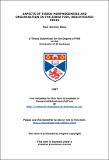Files in this item
Aspects of tissue morphogenesis and organisation in the zebra fish, Brachydanio rerio
Item metadata
| dc.contributor.advisor | Tucker, J. B. | |
| dc.contributor.author | Paul, Jeremy Dane | |
| dc.coverage.spatial | 218 | en_US |
| dc.date.accessioned | 2015-07-29T15:41:26Z | |
| dc.date.available | 2015-07-29T15:41:26Z | |
| dc.date.issued | 1987 | |
| dc.identifier | uk.bl.ethos.377332 | |
| dc.identifier.uri | https://hdl.handle.net/10023/7075 | |
| dc.description.abstract | This thesis is mainly concerned with the impact of cellular mechanisms which influence a particular instance of tissue morphogenesis, namely development of the caudal fin of the zebra fish, Brachydanio rerio. Ultrastructural analysis of fin fold morphogenesis in situ reveals that specific changes in epidermal cell shaping occur as a transient ectodermal ridge is generated. The ridge is converted to a fin fold by further changes in cell shaping which are spatio-temporally associated with the deposition of extracellular matrix material. Microsurgical excisions of small portions of early folds support the suggestion that cell shape modulation and extracellular matrix organisation interact reciprocally during early fold formation. Studies using cytochalisin B show that actinoid microfilaments play an important role in generating the changes in epidermal cell shaping associated with fin fold morphogenesis. They also eJiminate the possibility that overlying peridermis and e(Xiermis which flank putative fin folds exert any great influence on the morphology of fold epidermis during apical ectodermal ridge generation. Furthermore, experiments employing tunicamycin indicate that cell adhesion and extracellular matrix deployment are partic.llarly important in converting the apical ectodermal ridge into a fin fold and in subsequent stabilisation of the early fin fold. Microtubules do not appear to influence early fin fold morphogenesis although they are important during a later phase of fin fold expansion. The spatial relationships between extracellular matrix orientation and cytoskeletal alignment in cell layers associated with the scales of certain teleosts have also been assessed. These studies have involved electron and immunufluorescence microscopy. They show that fibroblastic cells found at varying locations on the surfaces of scales display three types of micro- tubule arrays. Two of these arrays show intercellular alignment of microtubules which are spatially correlated with patterns of extracellular matrix deposition. | en_US |
| dc.language.iso | en | en_US |
| dc.publisher | University of St Andrews | |
| dc.rights | Creative Commons Attribution-NonCommercial-NoDerivatives 4.0 International | |
| dc.rights.uri | http://creativecommons.org/licenses/by-nc-nd/4.0/ | |
| dc.subject.lcc | QL638.B7D2 | |
| dc.title | Aspects of tissue morphogenesis and organisation in the zebra fish, Brachydanio rerio | en_US |
| dc.type | Thesis | en_US |
| dc.type.qualificationlevel | Doctoral | en_US |
| dc.type.qualificationname | PhD Doctor of Philosophy | en_US |
| dc.publisher.institution | The University of St Andrews | en_US |
This item appears in the following Collection(s)
Except where otherwise noted within the work, this item's licence for re-use is described as Creative Commons Attribution-NonCommercial-NoDerivatives 4.0 International
Items in the St Andrews Research Repository are protected by copyright, with all rights reserved, unless otherwise indicated.


